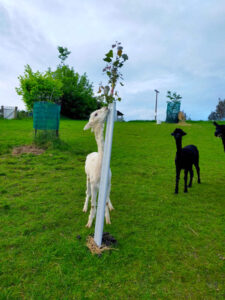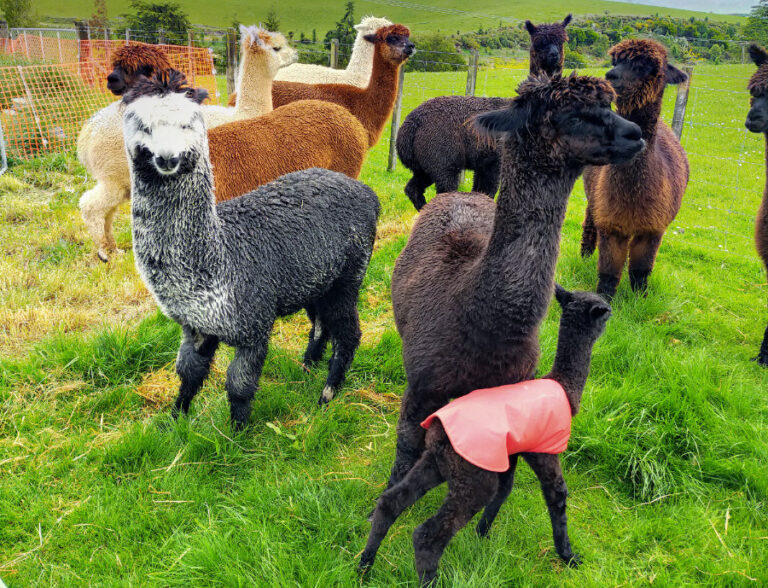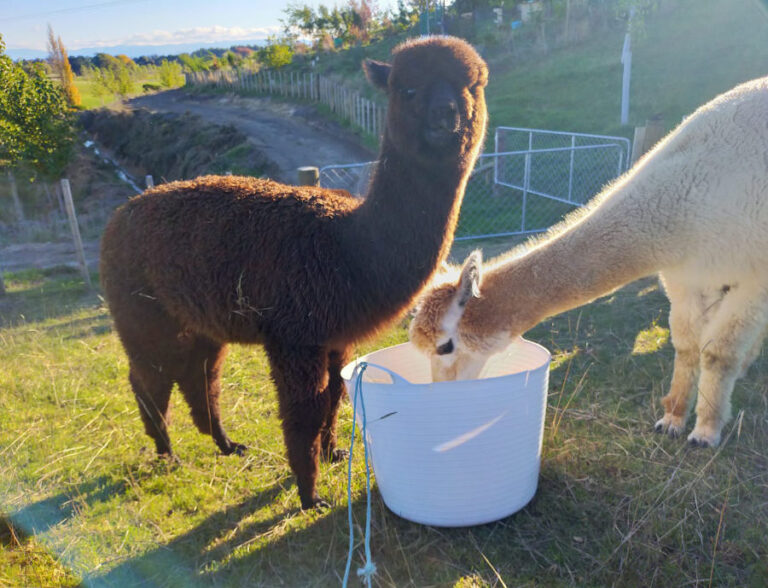RESOURCES
ALPACAS
First of all, it’s important to understand that alpaca are a herd animal and as such should never be kept alone. They are easy to keep, don’t require a lot of water or huge amounts of feed and provide a wonderful fibre once a year. They’ll encourage you to learn skills besides animal husbandry, such as carding, spinning, felting or weaving. And of course, they provide a good stress relief, as you get to watch their antics as they go about their daily routines.
Llamas are bigger 😉 They are both members of the camel family, Camelidae. The main differences are their size, the quality of their fibre (alpaca is better) and the shapes of their heads.
The main difference is the fibre you get from the alpaca. Huacaya fibre tends to be more “woolly”, whilst Suri is more silky and can almost look like dreadlocks.
Mostly grass, but they should also have access to hay and fresh water. They love to eat tree leaves such as Willow or Poplar and ours seem to be addicted to Tree Lucerne. (See section below on trees to avoid). They also enjoy treats such as alpaca pellets and apples cut up into small pieces.
SOILS/GRASSES/FORAGE
We are always learning new ways and old ways of working with our environment to help benefit our alpacas and the planet. Here we gathered a few resources that we’ve found useful on various aspects of the farm itself.
Here’s a helpful article on the effectiveness of different grass types. Note, that with their susceptibility to rye grass staggers, it’s best to steer clear of rye and look more at the Fescues or Cocks Foot grass types.
On-farm establishment of drought-tolerant pastures on the east coast of the North Island
 All animals benefit from the provision of shade, not only from sun but also from the other elements of wind and rain. Alpacas are no different. If your paddocks lack shade then there are a variety of ways of establishing trees even with animals as tall as alpacas. Look for nurseries that sell Poplar and Willow poles. These are usually 2-3m cuttings taken from the rootstock in autumn and planted out in the winter. Hawkes Bay Regional council have a lot of useful information on their site.
All animals benefit from the provision of shade, not only from sun but also from the other elements of wind and rain. Alpacas are no different. If your paddocks lack shade then there are a variety of ways of establishing trees even with animals as tall as alpacas. Look for nurseries that sell Poplar and Willow poles. These are usually 2-3m cuttings taken from the rootstock in autumn and planted out in the winter. Hawkes Bay Regional council have a lot of useful information on their site.
We’ve used 1.7m Dynex sleeves on the poles, some of the alpaca will get up on their hind legs to try to get to the leaves but the trees will survive. The alapca don’t tend to rub on the trees, so they should be well established after about 3-5 years. After that a pollarding programme will ensure a very useful additional summer feed.
at least not for alpaca. A lot of plants are bad for all forms of livestock. Did you know that Black Cherry leaves contain cyanide that becomes more concentrated when a branch falls, enough to kill a cow or sheep but as alpaca are pseudo-ruminants the effects can be more pronounced due to their digestive system. Some of these plants have a near instantaneous effect where as others will have a longer term affect or may have side effects. It’s always worth reading up on the latest research work as alpaca are still very much a work in progress from a scientific point of view and recommendations will change with time. Here’s a link that lists the trees and plants to avoid.
If you’ve decided to use Willow or Poplar as part of a silvopasture approach, then it’s worth noting just how long it takes for the roots of the trees to establish poplar-root-developing-and-tree-spacing.
We all want to ensure that our alpaca don’t suffer the effect of “rye grass staggers”, caused by endophytes. The alternatives are to use grasses such as Fescue or Cocks Foot but also Timothy. Included in these can be clovers, plantain and chicory. Remember that you’re surrounded!! Not to be alarmist, but if the majority of the paddocks around you will be rye grass based, as such they will encroach over time, so you will need to oversow to maintain a non-rye base.
There’s pretty much anything an alpaca will do to get to tagasaste (Tree Lucerne). They just have to beat the keruru to get to it first. We’ve found that it’s quick to establish, provides an excellent windbreak and is vigorous to regrow.
If you decide to feed your alapca with tree fodder, they may eat all the leaves and some of the smaller branches, but that’ll leave a non trivial amount of twigs and branches. At our place that has proven to be a real benefit, every week we chip all those branches down and in next to no time we have a wonderful mulch to put on the garden and veggie beds. A nice circular solution.


